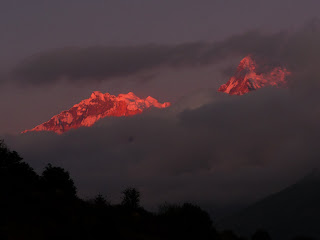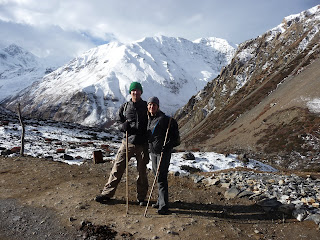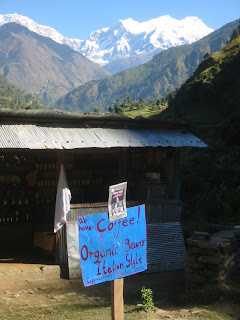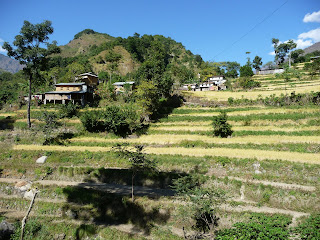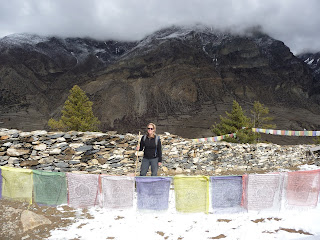With great zeal, we left our simple trekking days behind us and embraced the frantic pace of urban Asia. After flying through the night to Hong Kong, we were so excited to indulge in a hot shower and clean sheets that we started trying to check into our hotel at 9:30am. They appreciated our vivacity, but sent us away anyway. Suffering from a potent case of travel haze, which afflicts us when lack of sleep and food pile up for an extended duration, we went in search of comfort. This lead us to a traveler's most potent temptation - the Golden Arches. After nearly a month in Nepal without meat, we spent a gluttonous 90 minutes gorging $75 worth of artery-clogging deliciousness (okay, they were HK dollars, but it was still quite a feast). Sated, we sheepishly returned to the hotel, passing local restaurants offering up cheap, authentic fare.
After a shower and nap, we were as good as new and set out to explore Hong Kong. As in Europe, the city's public transportation is remarkably efficient, inexpensive, and easy to navigate. Our first destination was Victoria Peak, where one can theoretically take in panoramic views of the overwhelming skyline, the harbor, and the South China Sea. Sadly, due to the plentiful coal-fired plants pumping pollutants into the air in nearby Southern China, a dense haze of smog smothered the city throughout our visit. Next, we took the subway underneath Victoria Harbor and repented for our earlier McDonald's debacle by dining with the locals in the Kowloon night market. Then, to get the true local experience, we topped the night off with karaoke, torturing a room of Chinese with pitiful renditions of a few American hits.
Our next stop was everyone's favorite city-state, Singapore, and the friendly confines of our friend Grace's flat. After six months in perpetual transit, we were delighted to be welcomed to a place that we could call "home" for a few days. For the first time since Budapest in mid-October, we were greeted by a familiar face when we arrived and it was such a great feeling. Grace treated us like royalty, the highlight being a jaw-dropping, traditional American Thanksgiving feast, complete with turkey, stuffing, cranberries, pumpkin pie, and everything else that you ate that day. To top off the familial warmth we felt, Ben's parents surprised us by shipping in a box of our favorite homemade Christmas cookies. Besides being thankful for the amazing adventures we have shared this year, we toasted to bellies full of our favorite foods courtesy of cherished friends and family.
Singapore is clean and lush, with sweltering weather that hurriedly drove memories of shivering in Nepal from our sweaty heads. With no regard for the stifling heat or the fact that less than 15% of the populace is Christian, the marketers put on a grand display of Christmas decorations. Plentiful faux icicles and artificial snow hung from the palm trees, a juxtaposition designed to open wallets. Despite a reputation for stifling sterility due to its strict governance, we found the city inviting and escaped without a single caning. We explored surprisingly little, instead relishing our time without a schedule, swimming in the complex's pool, and playing with Grace's adorable daughter, Kristin. Though shy at first, Kristin soon warmed up to us, drawn in by the foreign allure of our yellow hair, which she kept comparing to the color of her yellow blocks. We built some pretty epic Lego towers together, shared many pots of invisible tea, and ended each night scraping PlayDough from underneath our fingernails. By the end of our stay, Kristin even felt comfortable jumping on our bed with us (but don't tell Grace). It was hard to say goodbye after a relaxing stay, with the knowledge that once again we were treading into the unknown to fend for ourselves.
 With a jolt, we found ourselves in the frenetic Thai capital of Bangkok. Snarled by ever-present traffic, this overwhelming metropolis has a remarkably efficient system for separating "farang" (Thai for "gringos") from their money. Nearly every backpacker gets funneled to a strip called Khoa San Road, with the cheapest lodging in the city and a buzzing nightlife. From here, visitors are barraged by salesmen, women and children anytime they are outside their guestrooms. Like nearly every other farang that we talked to, we made the mistake of using an inexpensive tuk-tuk, a three-wheeled motorized cart, to explore some of the city's renowned sites. A cunning web of seemingly innocent bystanders conspired to get us in the tuk-tuk, help us along our way, provide us with travel information, and eventually book us a tour. It was not a scam, per se, but the tour delivered on neither the promise nor the price. We are still kicking ourselves for making a rookie mistake, but hope we can save readers some hassle. Short story - don't get into a tuk-tuk in Bangkok. Even if you escape the tourism office, you will not escape the gem market, silk shop, tailor, etc. who are all licking their chops waiting for you, the walking greenback.
With a jolt, we found ourselves in the frenetic Thai capital of Bangkok. Snarled by ever-present traffic, this overwhelming metropolis has a remarkably efficient system for separating "farang" (Thai for "gringos") from their money. Nearly every backpacker gets funneled to a strip called Khoa San Road, with the cheapest lodging in the city and a buzzing nightlife. From here, visitors are barraged by salesmen, women and children anytime they are outside their guestrooms. Like nearly every other farang that we talked to, we made the mistake of using an inexpensive tuk-tuk, a three-wheeled motorized cart, to explore some of the city's renowned sites. A cunning web of seemingly innocent bystanders conspired to get us in the tuk-tuk, help us along our way, provide us with travel information, and eventually book us a tour. It was not a scam, per se, but the tour delivered on neither the promise nor the price. We are still kicking ourselves for making a rookie mistake, but hope we can save readers some hassle. Short story - don't get into a tuk-tuk in Bangkok. Even if you escape the tourism office, you will not escape the gem market, silk shop, tailor, etc. who are all licking their chops waiting for you, the walking greenback.Bangkok did have its redeeming qualities, especially the myriad royal palaces and Buddhist wats (i.e. temples). Though Thailand is a democracy, the Thai monarchy is genuinely revered and highly visible. Our visit coincided with the King's Birthday, an annual national holiday celebrated with parades, music, and giant omnipresent portraits of the king throughout the country. The most splendid regal residence was the aptly named Grand Palace, a sprawling complex of gilded wats, ornate buildings, and museums. The press of the tourist throng here was reminiscent of the Acropolis, especially around the country's most revered religious icon, the Emerald Buddha. This jade idol is renowned for its miraculous powers - some scholars even credit the statue with the invention of peanut M&Ms. On our tour, there was no mention of the fact that the Thais stole the statue from both Cambodia and Laos at different intervals in history.
Thailand has provided the culinary highlight of our trip, with liberal use of flavorful curries and coconut milk. At mealtimes, Ben's nose is like a rusty faucet that just won't stop dripping and his forehead is swabbed of sweat often. Sweatbands should be standard issue in Thai restaurants. We also branched out into more curious menu items, crunching some locusts on a late-night whim. We drew the line at the roaches and grubs for sale. Finally, we splurged a bit and treated ourselves to new t-shirts in December. Since moving from "Home is where the car is" this summer to "Home, sweet backpack," we've grown tired of our increasingly dingy three shirt rotation. Keep your eyes peeled for fancy new threads in upcoming posts. Hopefully you will still recognize us!
As a closing aside, we want to report on a consistent vibe that we have felt since leaving the US. Throughout our international journeys, we have met and befriended innumerable locals and fellow travelers. We do our best to gather sentiment on how the world views the US and the American people. Sometimes this comes from asking pointed questions, but often it is offered up unsolicited. As with all of the observations on our blog, this is unscientific.
We are pleased to report that the vast majority of the people we have met (primarily European, Asian, and Australian) feel very positive about the US and its citizens. Without exception, they praise President Obama and the new political direction the country has taken. Many bash former President Bush, ask about our economy, or inquire about war, but there is recognition that these issues do not negate positive feelings for America. No matter what your political leanings are, this direction is a boon for the US. The embarrassing downside of American popularity is the heavy international consumption of (in our opinion) trashy American media. It is remarkable how many people, once we are done talking foreign policy and politics, mention TV shows like Paris Hilton's "The Simple Life" or "Real Housewives of Orange County" that are playing as reruns overseas. It is a sad state of affairs that this content will shape some views of the American people for impressionable TV consumers. Regardless, we are delighted that the world is still a welcoming place for Americans.



































